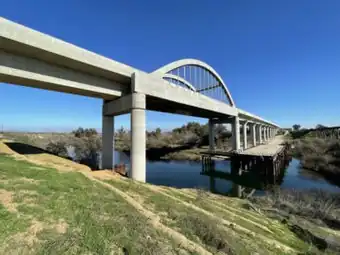California High-Speed Rail
California High-Speed Rail (also known as CAHSR or CHSR) is a publicly funded high-speed rail system currently being developed in California in the United States. In 1996, the California Legislature and Governor Pete Wilson established the California High-Speed Rail Authority with the task of creating a plan for the system and then presenting it to the voters of the state for approval. In 2008, voters approved the plan given in Proposition 1A, which specified a route connecting all the major population centers of the state, authorized the issuance of bonds for beginning implementation, and established other requirements.
| California High-Speed Rail | |||||||||||||||||||||||||||||||||||||||||||||||||||||||||||||||||||||||||||||||||||||||||||||||||||||||||||||||||||||||||||||||||||||||||||||||||||||||||||||||||||||||||||||||||||||||||||||||||||||||||||||||||||||||||||||||||||||||||||||||||||||||||||||||||||||||||||||||||||||||||||||||||||||||||||||||||||||||||||||||||||||||||||||||||||||||||||||||||||||||||||||||||||||||||||||||||||||||||||||||||||||||||||||||||||||||||||||||||||||||||||||||||||||||||||||
|---|---|---|---|---|---|---|---|---|---|---|---|---|---|---|---|---|---|---|---|---|---|---|---|---|---|---|---|---|---|---|---|---|---|---|---|---|---|---|---|---|---|---|---|---|---|---|---|---|---|---|---|---|---|---|---|---|---|---|---|---|---|---|---|---|---|---|---|---|---|---|---|---|---|---|---|---|---|---|---|---|---|---|---|---|---|---|---|---|---|---|---|---|---|---|---|---|---|---|---|---|---|---|---|---|---|---|---|---|---|---|---|---|---|---|---|---|---|---|---|---|---|---|---|---|---|---|---|---|---|---|---|---|---|---|---|---|---|---|---|---|---|---|---|---|---|---|---|---|---|---|---|---|---|---|---|---|---|---|---|---|---|---|---|---|---|---|---|---|---|---|---|---|---|---|---|---|---|---|---|---|---|---|---|---|---|---|---|---|---|---|---|---|---|---|---|---|---|---|---|---|---|---|---|---|---|---|---|---|---|---|---|---|---|---|---|---|---|---|---|---|---|---|---|---|---|---|---|---|---|---|---|---|---|---|---|---|---|---|---|---|---|---|---|---|---|---|---|---|---|---|---|---|---|---|---|---|---|---|---|---|---|---|---|---|---|---|---|---|---|---|---|---|---|---|---|---|---|---|---|---|---|---|---|---|---|---|---|---|---|---|---|---|---|---|---|---|---|---|---|---|---|---|---|---|---|---|---|---|---|---|---|---|---|---|---|---|---|---|---|---|---|---|---|---|---|---|---|---|---|---|---|---|---|---|---|---|---|---|---|---|---|---|---|---|---|---|---|---|---|---|---|---|---|---|---|---|---|---|---|---|---|---|---|---|---|---|---|---|---|---|---|---|---|---|---|---|---|---|---|---|---|---|---|---|---|---|---|---|---|---|---|---|---|---|---|---|---|---|---|---|---|---|---|---|---|---|---|---|---|---|---|---|---|---|---|---|---|---|---|---|---|---|---|---|---|---|---|---|---|---|---|---|---|---|---|---|---|---|---|---|---|---|---|---|---|---|---|---|---|---|---|---|---|---|---|---|---|---|---|---|---|
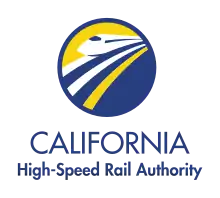 | |||||||||||||||||||||||||||||||||||||||||||||||||||||||||||||||||||||||||||||||||||||||||||||||||||||||||||||||||||||||||||||||||||||||||||||||||||||||||||||||||||||||||||||||||||||||||||||||||||||||||||||||||||||||||||||||||||||||||||||||||||||||||||||||||||||||||||||||||||||||||||||||||||||||||||||||||||||||||||||||||||||||||||||||||||||||||||||||||||||||||||||||||||||||||||||||||||||||||||||||||||||||||||||||||||||||||||||||||||||||||||||||||||||||||||||
 San Joaquin River Viaduct under construction in 2019. | |||||||||||||||||||||||||||||||||||||||||||||||||||||||||||||||||||||||||||||||||||||||||||||||||||||||||||||||||||||||||||||||||||||||||||||||||||||||||||||||||||||||||||||||||||||||||||||||||||||||||||||||||||||||||||||||||||||||||||||||||||||||||||||||||||||||||||||||||||||||||||||||||||||||||||||||||||||||||||||||||||||||||||||||||||||||||||||||||||||||||||||||||||||||||||||||||||||||||||||||||||||||||||||||||||||||||||||||||||||||||||||||||||||||||||||
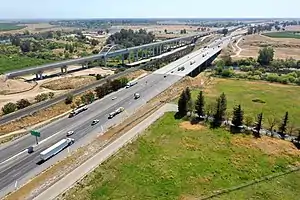 | |||||||||||||||||||||||||||||||||||||||||||||||||||||||||||||||||||||||||||||||||||||||||||||||||||||||||||||||||||||||||||||||||||||||||||||||||||||||||||||||||||||||||||||||||||||||||||||||||||||||||||||||||||||||||||||||||||||||||||||||||||||||||||||||||||||||||||||||||||||||||||||||||||||||||||||||||||||||||||||||||||||||||||||||||||||||||||||||||||||||||||||||||||||||||||||||||||||||||||||||||||||||||||||||||||||||||||||||||||||||||||||||||||||||||||||
| Overview | |||||||||||||||||||||||||||||||||||||||||||||||||||||||||||||||||||||||||||||||||||||||||||||||||||||||||||||||||||||||||||||||||||||||||||||||||||||||||||||||||||||||||||||||||||||||||||||||||||||||||||||||||||||||||||||||||||||||||||||||||||||||||||||||||||||||||||||||||||||||||||||||||||||||||||||||||||||||||||||||||||||||||||||||||||||||||||||||||||||||||||||||||||||||||||||||||||||||||||||||||||||||||||||||||||||||||||||||||||||||||||||||||||||||||||||
| Owner | California High-Speed Rail Authority
an agency of the State of California | ||||||||||||||||||||||||||||||||||||||||||||||||||||||||||||||||||||||||||||||||||||||||||||||||||||||||||||||||||||||||||||||||||||||||||||||||||||||||||||||||||||||||||||||||||||||||||||||||||||||||||||||||||||||||||||||||||||||||||||||||||||||||||||||||||||||||||||||||||||||||||||||||||||||||||||||||||||||||||||||||||||||||||||||||||||||||||||||||||||||||||||||||||||||||||||||||||||||||||||||||||||||||||||||||||||||||||||||||||||||||||||||||||||||||||||
| Area served | Interim Initial Operating Segment (Interim IOS) now being developed in San Joaquin Valley (Merced to Bakersfield); Planned Phase 1 extensions: north to San Francisco Bay Area south to Greater Los Angeles; Future extensions for Phase 2: north to Sacramento, California south to San Diego, California | ||||||||||||||||||||||||||||||||||||||||||||||||||||||||||||||||||||||||||||||||||||||||||||||||||||||||||||||||||||||||||||||||||||||||||||||||||||||||||||||||||||||||||||||||||||||||||||||||||||||||||||||||||||||||||||||||||||||||||||||||||||||||||||||||||||||||||||||||||||||||||||||||||||||||||||||||||||||||||||||||||||||||||||||||||||||||||||||||||||||||||||||||||||||||||||||||||||||||||||||||||||||||||||||||||||||||||||||||||||||||||||||||||||||||||||
| Locale | California, United States | ||||||||||||||||||||||||||||||||||||||||||||||||||||||||||||||||||||||||||||||||||||||||||||||||||||||||||||||||||||||||||||||||||||||||||||||||||||||||||||||||||||||||||||||||||||||||||||||||||||||||||||||||||||||||||||||||||||||||||||||||||||||||||||||||||||||||||||||||||||||||||||||||||||||||||||||||||||||||||||||||||||||||||||||||||||||||||||||||||||||||||||||||||||||||||||||||||||||||||||||||||||||||||||||||||||||||||||||||||||||||||||||||||||||||||||
| Transit type | High-speed rail | ||||||||||||||||||||||||||||||||||||||||||||||||||||||||||||||||||||||||||||||||||||||||||||||||||||||||||||||||||||||||||||||||||||||||||||||||||||||||||||||||||||||||||||||||||||||||||||||||||||||||||||||||||||||||||||||||||||||||||||||||||||||||||||||||||||||||||||||||||||||||||||||||||||||||||||||||||||||||||||||||||||||||||||||||||||||||||||||||||||||||||||||||||||||||||||||||||||||||||||||||||||||||||||||||||||||||||||||||||||||||||||||||||||||||||||
| Number of stations | 5 proposed in Interim IOS; up to 24 authorized in completed system | ||||||||||||||||||||||||||||||||||||||||||||||||||||||||||||||||||||||||||||||||||||||||||||||||||||||||||||||||||||||||||||||||||||||||||||||||||||||||||||||||||||||||||||||||||||||||||||||||||||||||||||||||||||||||||||||||||||||||||||||||||||||||||||||||||||||||||||||||||||||||||||||||||||||||||||||||||||||||||||||||||||||||||||||||||||||||||||||||||||||||||||||||||||||||||||||||||||||||||||||||||||||||||||||||||||||||||||||||||||||||||||||||||||||||||||
| Chief executive | Brian P. Kelly | ||||||||||||||||||||||||||||||||||||||||||||||||||||||||||||||||||||||||||||||||||||||||||||||||||||||||||||||||||||||||||||||||||||||||||||||||||||||||||||||||||||||||||||||||||||||||||||||||||||||||||||||||||||||||||||||||||||||||||||||||||||||||||||||||||||||||||||||||||||||||||||||||||||||||||||||||||||||||||||||||||||||||||||||||||||||||||||||||||||||||||||||||||||||||||||||||||||||||||||||||||||||||||||||||||||||||||||||||||||||||||||||||||||||||||||
| Website | |||||||||||||||||||||||||||||||||||||||||||||||||||||||||||||||||||||||||||||||||||||||||||||||||||||||||||||||||||||||||||||||||||||||||||||||||||||||||||||||||||||||||||||||||||||||||||||||||||||||||||||||||||||||||||||||||||||||||||||||||||||||||||||||||||||||||||||||||||||||||||||||||||||||||||||||||||||||||||||||||||||||||||||||||||||||||||||||||||||||||||||||||||||||||||||||||||||||||||||||||||||||||||||||||||||||||||||||||||||||||||||||||||||||||||||
| Operation | |||||||||||||||||||||||||||||||||||||||||||||||||||||||||||||||||||||||||||||||||||||||||||||||||||||||||||||||||||||||||||||||||||||||||||||||||||||||||||||||||||||||||||||||||||||||||||||||||||||||||||||||||||||||||||||||||||||||||||||||||||||||||||||||||||||||||||||||||||||||||||||||||||||||||||||||||||||||||||||||||||||||||||||||||||||||||||||||||||||||||||||||||||||||||||||||||||||||||||||||||||||||||||||||||||||||||||||||||||||||||||||||||||||||||||||
| Operation will start | 2030 (Interim IOS: Merced to Bakersfield) | ||||||||||||||||||||||||||||||||||||||||||||||||||||||||||||||||||||||||||||||||||||||||||||||||||||||||||||||||||||||||||||||||||||||||||||||||||||||||||||||||||||||||||||||||||||||||||||||||||||||||||||||||||||||||||||||||||||||||||||||||||||||||||||||||||||||||||||||||||||||||||||||||||||||||||||||||||||||||||||||||||||||||||||||||||||||||||||||||||||||||||||||||||||||||||||||||||||||||||||||||||||||||||||||||||||||||||||||||||||||||||||||||||||||||||||
| Operator(s) | DB E.C.O. North America Inc. | ||||||||||||||||||||||||||||||||||||||||||||||||||||||||||||||||||||||||||||||||||||||||||||||||||||||||||||||||||||||||||||||||||||||||||||||||||||||||||||||||||||||||||||||||||||||||||||||||||||||||||||||||||||||||||||||||||||||||||||||||||||||||||||||||||||||||||||||||||||||||||||||||||||||||||||||||||||||||||||||||||||||||||||||||||||||||||||||||||||||||||||||||||||||||||||||||||||||||||||||||||||||||||||||||||||||||||||||||||||||||||||||||||||||||||||
| Technical | |||||||||||||||||||||||||||||||||||||||||||||||||||||||||||||||||||||||||||||||||||||||||||||||||||||||||||||||||||||||||||||||||||||||||||||||||||||||||||||||||||||||||||||||||||||||||||||||||||||||||||||||||||||||||||||||||||||||||||||||||||||||||||||||||||||||||||||||||||||||||||||||||||||||||||||||||||||||||||||||||||||||||||||||||||||||||||||||||||||||||||||||||||||||||||||||||||||||||||||||||||||||||||||||||||||||||||||||||||||||||||||||||||||||||||||
| System length |
| ||||||||||||||||||||||||||||||||||||||||||||||||||||||||||||||||||||||||||||||||||||||||||||||||||||||||||||||||||||||||||||||||||||||||||||||||||||||||||||||||||||||||||||||||||||||||||||||||||||||||||||||||||||||||||||||||||||||||||||||||||||||||||||||||||||||||||||||||||||||||||||||||||||||||||||||||||||||||||||||||||||||||||||||||||||||||||||||||||||||||||||||||||||||||||||||||||||||||||||||||||||||||||||||||||||||||||||||||||||||||||||||||||||||||||||
| No. of tracks | 2 (plus 2 loading tracks in stations) | ||||||||||||||||||||||||||||||||||||||||||||||||||||||||||||||||||||||||||||||||||||||||||||||||||||||||||||||||||||||||||||||||||||||||||||||||||||||||||||||||||||||||||||||||||||||||||||||||||||||||||||||||||||||||||||||||||||||||||||||||||||||||||||||||||||||||||||||||||||||||||||||||||||||||||||||||||||||||||||||||||||||||||||||||||||||||||||||||||||||||||||||||||||||||||||||||||||||||||||||||||||||||||||||||||||||||||||||||||||||||||||||||||||||||||||
| Track gauge | 4 ft 8+1⁄2 in (1,435 mm) standard gauge | ||||||||||||||||||||||||||||||||||||||||||||||||||||||||||||||||||||||||||||||||||||||||||||||||||||||||||||||||||||||||||||||||||||||||||||||||||||||||||||||||||||||||||||||||||||||||||||||||||||||||||||||||||||||||||||||||||||||||||||||||||||||||||||||||||||||||||||||||||||||||||||||||||||||||||||||||||||||||||||||||||||||||||||||||||||||||||||||||||||||||||||||||||||||||||||||||||||||||||||||||||||||||||||||||||||||||||||||||||||||||||||||||||||||||||||
| Electrification | 25 kV 60 Hz AC overhead line[2][3] | ||||||||||||||||||||||||||||||||||||||||||||||||||||||||||||||||||||||||||||||||||||||||||||||||||||||||||||||||||||||||||||||||||||||||||||||||||||||||||||||||||||||||||||||||||||||||||||||||||||||||||||||||||||||||||||||||||||||||||||||||||||||||||||||||||||||||||||||||||||||||||||||||||||||||||||||||||||||||||||||||||||||||||||||||||||||||||||||||||||||||||||||||||||||||||||||||||||||||||||||||||||||||||||||||||||||||||||||||||||||||||||||||||||||||||||
| Top speed | 220 mph (350 km/h) maximum; 110 mph (180 km/h) San Francisco–Gilroy[4] & Los Angeles–Anaheim[5] | ||||||||||||||||||||||||||||||||||||||||||||||||||||||||||||||||||||||||||||||||||||||||||||||||||||||||||||||||||||||||||||||||||||||||||||||||||||||||||||||||||||||||||||||||||||||||||||||||||||||||||||||||||||||||||||||||||||||||||||||||||||||||||||||||||||||||||||||||||||||||||||||||||||||||||||||||||||||||||||||||||||||||||||||||||||||||||||||||||||||||||||||||||||||||||||||||||||||||||||||||||||||||||||||||||||||||||||||||||||||||||||||||||||||||||||
| |||||||||||||||||||||||||||||||||||||||||||||||||||||||||||||||||||||||||||||||||||||||||||||||||||||||||||||||||||||||||||||||||||||||||||||||||||||||||||||||||||||||||||||||||||||||||||||||||||||||||||||||||||||||||||||||||||||||||||||||||||||||||||||||||||||||||||||||||||||||||||||||||||||||||||||||||||||||||||||||||||||||||||||||||||||||||||||||||||||||||||||||||||||||||||||||||||||||||||||||||||||||||||||||||||||||||||||||||||||||||||||||||||||||||||||
The CAHSR system is currently being implemented in phased segments. Construction began in 2015 for the first of the dedicated HSR segments, the Interim Initial Operating Segment ("Interim IOS"), in the San Joaquin Valley portion of California's Central Valley. It will run from Merced to Bakersfield and is planned to begin operations in 2030 (or slightly later).[6] Concurrently, in the major metropolitan areas of San Francisco Bay Area and Greater Los Angeles, the commuter rail systems are being upgraded for improved safety and service, and to support a "blended system" in the future, with CAHSR sharing upgraded tracks, power systems, train control systems, and stations. Proposition 1A did not specify the use of a "blended system" in the large metropolitan areas; however, cost (and other) considerations forced the Authority to adopt this approach in 2012. Extending the Interim IOS to connect to the northern and southern metropolitan segments is dependent on future funding, so it is uncertain when (or even if) the IOS will ever link to the metropolitan areas.
Maximum train speeds will be about 220 miles per hour (350 km/h) in the dedicated HSR segments and about 110 miles per hour (180 km/h) in the blended segments. Per Proposition 1A, the nonstop trains between San Francisco and Los Angeles – which are about 350 miles (560 km) apart by air – must not exceed 2 hours and 40 minutes travel time.
The proposed high-speed rail system would provide environmental benefits (reduced pollution and carbon emissions), traffic benefits (improved passenger travel, reduced vehicular traffic, and reduced air travel congestion), and economic benefits (especially in the Central Valley). However, the implementation of the project has been controversial due to its selected route, its management inexperience, delays in land acquisition and construction, poor initial cost estimates and significant cost over-runs, and lack of funding to finish the entire system.
In March 2023, the California High-Speed Rail Peer Review Group (established by the California Legislature to independently appraise the project) raised some significant concerns about the project's continued viability. In March 2023 it noted:
Since its inception in 2008, the Group has issued 18 letters and members have testified before Legislative and Congressional committees 15 times. In reviewing past letters and testimony, a consistent theme emerges: 1) project costs, schedules, and ridership estimates are uncertain and subject to significant risk of deteriorating, a typical experience for mega-projects; 2) the project is underfunded, and its financing is unstable, raising costs and making effective management difficult if not impossible; 3) more legislative oversight is needed. This letter reinforces the message, but with a sense of urgency over the ever-higher stakes.[7]
Despite these significant concerns, the federal government continues to support the CAHSR system. Federal Railroad Administration (FRA) Administrator Amit Bose said, “This project is unparalleled, and the federal government will continue to partner with California to deliver passenger rail benefits that people want and deserve, The Department of Transportation and the Federal Railroad Administration will continue to stand shoulder to shoulder with the workers and the cities of California to deliver this project.”[8]
Status and plans as of September 2023
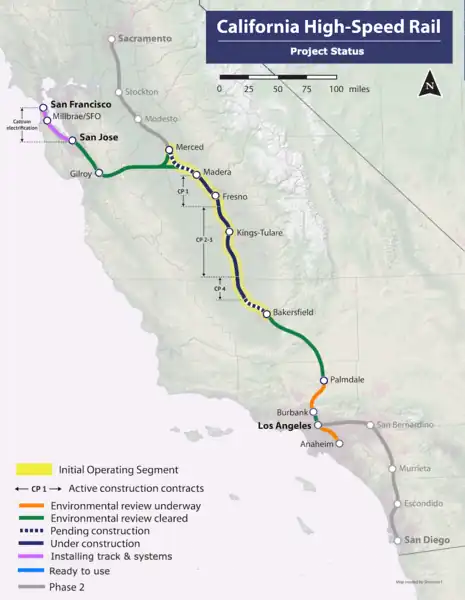
Project Status map at right displays route segment and construction status as of September 2023.
- IOS (Merced to Bakersfield) operational commencement date is the end of 2030.
- Current construction work is indicated (119-mile (192 km)) in the IOS.
- "Pending construction" has preliminary and design work currently proceeding (52-mile (84 km)) in the IOS. Funding is also beginning to be acquired.[9][10]
- "Environmental review cleared" is awaiting funding for planning, design, and construction.
- "Environmental review underway" is planned to be completed by end of 2024.
By 2022, there had been some significant concern about the slow pace of the project and its increasing costs. In June 2022, Governor Gavin Newsom pushed for the release of the last of the Proposition 1A bond funds in order to get an operating system working in the Central Valley.[11] In concert with this, he signed SB 198 into law. It requires the California High-Speed Rail Authority to make the Interim IOS (Merced to Bakersfield) its top priority.[12] Per the 2023 Project Update Report,[13] the Authority indicated the Interim IOS will go into service before December 31, 2030, with a 65% probability "risk factor" of three years (which runs until the end of 2033).
Although the top priority is the Merced to Bakersfield segment, this does not preclude doing some preliminary work on the next priority segment, from Merced across the coastal range to San Jose. After completing the Interim IOS, the Authority plans to advance construction on the Merced to San Jose segment, thereby linking the Interim IOS in the Central Valley to the tracks of the Caltrain commuter rail system. This will allow HSR trains to run from San Francisco to Bakersfield. The Authority is aggressively seeking additional federal funding for construction of this segment, which would necessitate costly boring of two long tunnels through the mountains.
The California High-Speed Rail Peer Review Group has noted a number of concerns about the progress of the project, including issues acquiring property in the Central Valley, delays due to lawsuits, an early lack of requisite management experience, cost overruns, and weak legislative oversight. Inflation has also become a major concern due to the disruptions caused by the COVID-19 pandemic and the war in Ukraine.[14]
The project will require legislative action, so the issues raised by the Peer Review Group and KPMG, the Authority's project consultant, will help the legislature select from the board's proposed plans or other alternatives.
From March 10, 2023, the California State Rail Modernization Plan (2023 Draft)[15] was available for review. This shows how the state anticipates the HSR system would integrate with other passenger rail systems in the state. There is also a two-page California State Rail Modernization Plan Factsheet available.[16]
IOS completion timeline
On pages 8 to 9 of the 2023 Project Update Report,[13] the current timeline for getting the IOS into operation is as follows:
- In mid-2024, commence track and systems installation when civil construction in CP 4 is completed; CP 1, and CP 2-3 are not expected to be ready for this until 2026
- In mid-2025, commence Madera and Bakersfield extensions civil construction, with completion estimated to be in mid-2028
- In mid-2026, commence station construction, with completion estimated to be in mid-2028
- In mid-2028, first trainset expected to be delivered
- In mid-2028, original 119-mile (192 km) segment to be completed
- In mid-2029, full IOS 172-mile (277 km) segment to be completed
- In mid-2029, static testing and dynamic testing to be completed, and operational testing to commence
- In mid-2030, trial operational running to be completed
- At end of 2030, passenger service to begin
However, note that the P65 probability envelope extends until the end of 2033.
Forthcoming Board actions
Note the last remaining Board meetings for 2023 are November 2, 2023, and December 21, 2023.[17]
Per the June 2023 CEO Report to the Board,[18] later in 2023 the Authority's board was expected to issue the following procurements:
- Contract modifications for utility relocations for current construction
- Installation of track and systems where civil construction works are completed
- Purchase of trains (i.e., rolling stock) for testing, commissioning, and in-service operations
The board was also to implement an improved procurement strategy that incorporates broader procurement methods, smaller contracts, increased flexibility, and an emphasis on maximizing qualified bidder pools. In developing its plans, the Authority used its own expert staff, experienced consultants, and the experiences of other mega-projects around the world.
The Authority produced a board presentation titled Upcoming Procurements: Track, Systems, Trainsets, & Related Procurements[19] for the August 24, 2023, board meeting. It discussed different procurement strategies in detail, laid out anticipated timelines for the different procurements, and discussed lessons learned and core principles to follow. The anticipated packages and timings were:
| Package | Scope | Description | Indicative timing (bold=done) |
|---|---|---|---|
| Package 1 (two separate contracts) | Track and Overhead Contact System (OCS) (Track Civil Works, Track Bed, Track, and OCS) | Package 1A: Design (Architectural & Engineering contract) Package 1B: Construction Manager/General Contractor (CM/GC) (CM/GC contract) | 1A: Q3 2023 1B: Q4 2023 |
| Package 2 | Systems (Signaling, train control, core communications and traction power system, Supervisory Control and Data Acquisition) | Package 2: Systems (Progressive Design-Build contract) | Q3 2023 |
| Package 3 (two separate steps) | Trainsets | Package 3: Trainsets RFQ (request for qualifications, prospective bidders) RFP (request for proposals) (Supply-Maintain contract) | RFQ: Q3 2023 RFP: Q1 2024 |
| Package 4 | Depots/Facilities | Package 4: Depots/Facilities (Packaging and scope of depots/facilities subject to ongoing discussion) | Q4 2023 |
| Additional Contracts | Program-wide support for Track and Systems |
|
|
At the CHSR Authority Board meeting of August 24, 2023, the Board approved the RFQ for the trainsets (NEWS RELEASE: California High-Speed Rail Authority Moves Closer to Buying First Trainsets), and the press release also discusses the process of acquisition in some detail.[20] The actual draft of the 105 page RFQ can be found here.[21] (Note that the actual train specifications will be found in the RFP when it is available.)
Phased implementation plan as of August 2023
Phase 1 runs from San Francisco to Los Angeles and Anaheim, and is being implemented in sections. In the Central Valley, there is construction underway and more is in preliminary processing.[22] The Authority is currently constructing 119 miles (190 km) of guideway and structures. To make the Interim Initial Operating Segment ("Interim IOS") self-sustaining, additional length is in the process being added at each end to reach the cities of Merced (north) and Bakersfield (south) for a total length of about 171 miles (275 km).[23] At each end, the Interim IOS will connect to other transit systems for passenger transfers. "Bookend" investments are also being made in the Bay Area and Southern California, upgrading existing infrastructure to improve local rail transit as well as support eventual HSR service.[24]
Per the 2023 Project Update Report,[13] "In consultation with the Federal Railroad Administration (FRA), and in light of cost estimates, the Authority is proposing to construct [the] Merced and Bakersfield [extensions] in phases as federal funding is awarded." The August 24, 2024 Authority Board meeting documents also noted that there is a $194 million dollar Federal-State Partnership for Intercity Passenger Rail grant request for configuration design for the Merced to San Jose and Bakersfield to Palmdale segments, geotechnical studies in the Pacheco Pass and Tehachapi Mountains, and other pre-construction work.[25]
The next implementation priority of the Authority is to provide an HSR link from the Interim Initial Operating Segment to Gilroy (to the west of Merced) and a "blended" system link to San Jose (to the north of Gilroy). This would enable a "blended" route from San Francisco to Gilroy and an HSR route from Gilroy to Bakersfield. This would allow HSR trains to provide a "one-seat ride" from San Francisco to Bakersfield. Also, note that it was estimated that 6 years will be required to bore the two tunnels on this segment, so getting this started early might need to be a priority. However, there is no funding as yet identified for this segment or for the following ones.[26]
The last major construction element in Phase 1 is to complete the route from Bakersfield south to Anaheim (in the Greater Los Angeles area). The section from Palmdale to Burbank will require the most tunneling, over 40 miles of tunnel divided among 13 separate tunnels. Two of these tunnels will be among the longest in the world, at over 13 miles each.[27] While future planning and funding to complete this segment are indeterminate, part of it already has had some "bookend" investments made in the metropolitan areas.
Per Proposition 1A, Phase 1 must be operational before Phase 2 is built. Phase 2 will extend the HSR system north to Sacramento and south to San Diego. These extensions are still in the preliminary planning stages.
2022 Business Plan and 2023 Project Update Report
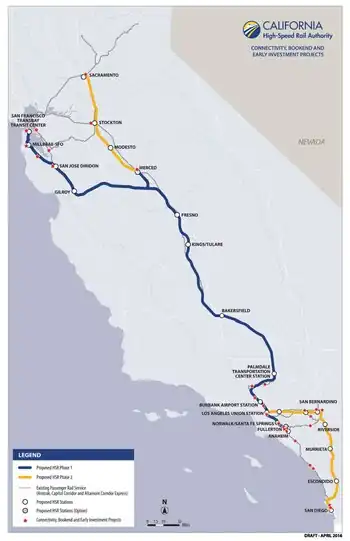
The 2023 Project Update Report[13] was released on March 1, 2023. Some of the updated information included was:
- An updated program baseline budget and schedule
- Updated capital costs to complete Phase 1
The 2022 Business Plan[28] included information regarding the project's status, goals, and activities. In order to make an effective, self-supporting Initial Operating Segment, due to financial constraints, the Authority was focusing on five areas:
- Creating the infrastructure for a viable Interim IOS. That means adding the additional 52 miles (84 km) to create an 171-mile (275 km) HSR-operable segment between Merced and Bakersfield, and creating the train stations along the route. Advanced design contracts were awarded for both extensions, and work on route acquisition and construction was to be performed as funding becomes available.[29][30][31] On October 10, 2022, the contract for the first phase of station creation (expected to take about 30 months) was let.[32]
- Creating an operational HSR system for testing. A track and systems contract will need to be let to install tracks, power, and control systems for the initial 119 miles (192 km) of right-of-way, and HSR train sets will need to be acquired to test on it. When the track and systems work along the initial 119 miles (192 km) is completed (the 2023 Project Update Report projects this to be by 2028), there will be a two-year period of testing the HSR trainsets, trackage, and control systems while construction proceeds on the Merced and Bakersfield extensions. The Authority plans to restructure and re-issue the track and systems procurement in 2023.[33] The Authority has applied for federal funds to purchase six trainsets capable of speeds in excess of 200 miles per hour (320 km/h).[34] The 2023 Project Update Report projects the purchase of these to be made in 2024.
- Readying the entire Phase 1 system for construction. The segments from San Francisco to Palmdale and from Burbank to Los Angeles were already environmentally cleared. Palmdale to Burbank was expected to be approved in 2023, and Los Angeles to Anaheim in 2024. As each segment is cleared, the Authority plans to complete its advanced design and engineering. The goal was to have all segments in Phase 1 ready for construction when funding became available.[35]
- Continuing to advance "bookend" investments. In Northern California, these include electrification of Caltrain, grade separations, and an automatic train control system between San Francisco and San Jose. The Authority will also be working with Union Pacific Railroad to extend electrification to Gilroy, since the selected "blended" route between San Jose and Gilroy uses the UPRR alignment. In Southern California, these include phase A of Link Union Station, which through-tracks LA Union Station, and other improvements, such as early grade separations in the Burbank-to-Los Angeles shared corridor, the Rosecrans–Marquardt grade separation, and an automatic train control system. These investments will provide immediate benefits in the San Francisco and Los Angeles areas, while also readying those transit systems for eventual shared use by HSR trainsets. (The 28 red stars in the map shown here indicate bookend investments in other rail systems.)
- Opening the Interim IOS to passenger traffic before 2031. SB 198 (passed by the legislature and signed into law in June 2022) prioritized getting the Interim IOS into operation.[12] The contracted early train operator (ETO) selected to run the system is DB ECO North America Inc. The plan is to have the Interim IOS run double-tracked from Merced to Bakersfield, have five stations (Merced, Madera, Fresno, Kings/Tulare, and Bakersfield), provide many more trips per day than current service, and operate the trains up to 220 miles per hour (350 km/h) for a significantly faster service.[22] The Merced station will provide a transfer point to the Altamont Corridor Express (ACE) and San Joaquins (Amtrak) rail routes to Sacramento and the Bay Area (San Francisco, Oakland, and San Jose) as well as local buses. The Bakersfield station will have a transfer to Thruway Bus Service for travel to Southern California.[36]
Also, a major addition to the development and operation plan was a new emphasis on risk analysis and risk mitigation (with these integrated into the formal authorization process), and contingency reserves were being increased. Revenue and expense projections indicated that constructing an operable 171-mile (275 km) segment is feasible.
Critique of 2023 Project Update Report
On March 23, 2023, the Peer Review Group sent a Letter to the Legislature (March 23, 2023)[37] reviewing the 2023 Project Update Report. In particular, the group noted the following major problems:
- increasing costs (while not out of line) would continue to pose significant problems
- "schedules continued to stretch out" and "There was no longer a projected completion date for the full Phase I system because there was no funding on which to base a credible schedule"
- ridership demand estimates had fallen, thus reducing the benefits of the system
- confidence forecasts may have easily been wrong because perhaps the most difficult forecasts (tunneling and electrification) had no real-world data to back them up
- inflation would continue to be a significant cost-increasing factor
- meeting local requests for modifications might have added significant cost increases (as had already happened)
- the Memorandum of Understanding between CalSTA, the Authority, and the San Joaquin Joint Powers Authority was a good start but did not properly cover funding issues
- the anticipated piecemeal federal money infusion was not a reliable or adequate funding process to base the project on
- the unfunded gap between known revenue and projected expenses was increasing
- the increasingly acute dilemma of putting the Merced to Bakersfield section into service may not have been worth it, since only the entire Phase 1 system may have delivered adequate returns on investment, and yet due to the apparently increasingly large funding gap of doing so, the state may have not been able to fully fund its implementation (It should be noted, however, that the costs and benefits of implementing the mid-position of the SF to Bakersfield section was not discussed.)
These are all significant concerns, and there are no ready answers for them all. Ultimately, it is up to the legislature to determine what it wants to do with the system.
The letter goes on to list 9 "considerations for the legislature", including the appointment of an inspector general (IG), a caution that "It is critical that any funding approach be fully funded and stable and predictable from year to year" in a project of this magnitude and complexity, a review of potential cost-cutting measures in the Merced to Bakersfield section, and a review of the Authority's staffing and organizational structure keeping in mind forthcoming operational demands.
Financial status and plans

The CAHSR's latest financial projections are discussed in detail in its 2022 Proposition 1A Funding Plan (September 2022)[38] and the 2023 Project Update Report[13] (which is discussed at the end of this section as well as the two paragraphs before this section). The legislature also had both of these documents reviewed by an independent accounting agency, and no significant problems were noted.[39]
As of September 2022, the Authority's plans indicated $23.4 billion in identified funding through 2030, with funds coming from Proposition 1A bonds, a number of federal grant program awards, and 25% of California's cap-and-trade auction proceeds. These will go towards a budgeted allocation of $17.9 billion for Central Valley construction (about 119 miles (192 km)), design work for the Merced and Bakersfield extensions, the "bookend" projects now underway, completing the environmental clearances and design work needed for all of Phase 1, station construction, plus $4.6 to $6.0 billion for double-trackage, extension construction, and trainsets for the Interim IOS.[28]: 59
As of November 2022, the Authority was seeking an additional $8 billion in funding via grants from the federal government. Should it be awarded, this funding will allow the Authority to leverage its resources and use the additional federal funds for:
- Double-tracking the initial 119 miles (the first priority)
- Construction and land acquisition to advance the extension south to Bakersfield
- Purchase of the trainsets needed for the Initial Operating Segment operations
- Design of the Merced and Bakersfield extensions
- Construction of the initial five HSR stations[40]
Per the 2022 Business Plan,[28] the expected new funding will be budgeted to:
- "Deliver an electrified two-track initial operating segment connecting Merced, Fresno and Bakersfield as soon as possible"
- Invest statewide to advance engineering and design work as every project section is environmentally cleared
- Leverage new federal and state funds for targeted statewide investments
- Develop a funding strategy to extend high-speed rail beyond the Central Valley and to the Bay Area as soon as possible"[41]: 3
The funding and budget strategy is now to leverage existing state funds and use matching federal funds to achieve the optimal result in project investments. Table 3.3 in the 2022 Business Plan (on p. 55) shows how the Authority is matching the proposed funding with the different project results. For example, "System-Wide Advancement/Start Bay Area Connection" (see figure above) includes advanced design as well as right-of-way acquisition in the San Jose to Merced segment.[41]: 55
Per the 2023 Project Update Report, there are significant inflationary pressures which will cause budget increases. The Authority reports that the cost increases projected are in line with other HSR project cost increases (e.g., the UK "HS2" HSR rail project, and the Gateway Project in the Northeast Corridor). The Authority is also approaching the extensions differently by advancing design to the configuration-level (generally about 30% of all design), and is procuring right-of-way in advance of construction work needs.
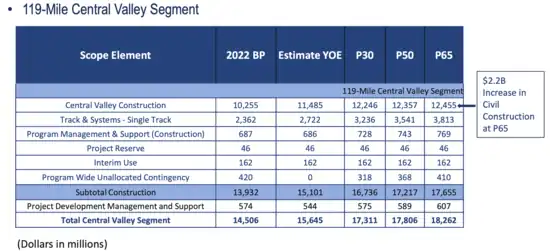
Early Operating Segment (Merced to Bakersfield): The total cost increase estimate until operational implementation of the Early Operating Segment (Merced to Bakersfield) at P65 is $7.5 billion. The total cost ranges from $29.8 billion to 32.9 billion.
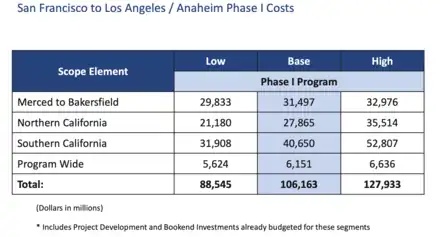
Northern California Extension (Merced to San Francisco): The total cost to operational implementation of the Northern California Extension (Merced to San Francisco) ranges from $21.2 billion to $35.5 billion. (See Notes below).
Southern California Extension (Bakersfield to Anaheim): The total cost to operational implementation of the Southern California Extension (Bakersfield to Anaheim) ranges from $31.9 billion to $52.8 billion. (See Notes below).
Entire Phase 1 System (San Francisco to Anaheim): The total cost to operational implementation of the Entire Phase 1 System (San Francisco to Anaheim) ranges from $88 billion to $128 billion. (See Notes below).
Notes: (1) A major unknown in these estimates is the cost of tunneling, which will not be known until exploratory field studies are done. (2) These estimates include all costs which have already been expended.
The 2023 Project Update Report notes that permanent funding programs do not exist for high-speed rail, either nationally or in California. Current CAHSR funding for the project is estimated at $25 billion. Of this, California has contributed about 85% ($21.5 billion, assuming cap-and-trade stays at current levels through 2030), and the federal government has contributed about 15% (roughly $3.5 billion). The 2022 Business Plan indicated additional federal funds would be needed to complete the Merced-to-Bakersfield segment, and set a target of $8 billion to be awarded from the Bipartisan Infrastructure Law for the project. If that target is achieved, about $33 billion would be directed to the project (about 65% state, 35% federal in total). Future state or federal funds of about $2 billion would address the full P65 cost estimate. However, there is no state funding assured after 2030, so ongoing funding will be a critical issue which will have to be addressed.
Power systems
Page 18 of the 2023 Project Update Report[13] discusses the stated goal of the Authority that the HSR system use 100% renewable energy. The Authority will also comply with SB 1020 (the Clean Energy, Jobs and Affordability Act of 2022) that commits the state to running its operations on clean, renewable energy resources by 2035, as well as SB 1203 that requires the state to achieve net-zero operations for all state agencies by 2035.
To achieve this, the Authority plans to install solar panels and battery systems at its traction power substations along its right of way. This power system is to tie into the state's power grid, so power is to be shared across both systems to the benefit of both systems.
The Authority is now doing conceptual designs of the solar and battery power system, its connections with Pacific Gas and Electric Company (PG&E), and preliminary financial modeling. It had been coordinating with PG&E and the California Independent System Operator (ISO), which manages the state's power grid. The power procurement strategy is anticipated to be finalized in 2023.
In the Interim IOS, approximately every 30 miles there will be a solar collection array along with a battery backup system. The units are being designed so that a minimum of 6 hours of "backup power" will be available even in winter. The Authority is continuing to investigate placement of the power units, and refine its model of energy production and consumption. In May 2023 the Authority applied for $53.7 million in Department of Energy Grid Resilience and Innovation Program (GRIP) grants.[42]
Inspector General
The August 2023 CEO Report to the Authority Board reported that Governor Newsom had appointed Benjamin Belnap as Inspector General of the California High-Speed Rail Authority as per SB 198. Belnap has been an employee of the State Auditor's office since 2001, and a Deputy State Auditor since 2015. He has a 4 year term, and will report to the Board on occasion.[43]
Construction status and plans
The groundbreaking ceremony for CAHSR was held on January 6, 2015, in Fresno, California.
Initial construction packages
In the Central Valley, major construction projects are underway. Three separate construction packages total 119 miles (192 km) of guideway and 93 structures.
| Guideway | |
|---|---|
| Planned | 119 miles (192 km) |
| Completed | 90 miles (140 km) |
| Remaining | 29 miles (47 km) |
Tables 4.1 through 4.3 in the 2023 Project Status Report show the status of each structure in each construction package. ("ROW Status" = Right-of-Way Status.) As of August 2023, 7 structures in the following construction packages have been completed in 2023.[46]
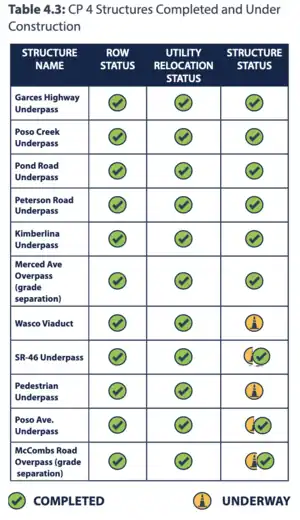
- CP4 comprises 22 miles (35 km) adjoining the end of CP2-3 to the intersection of Poplar / Madera Avenue northwest of Shafter. It includes at-grade embankments, retained-fill over-crossings, viaducts, aerial sections of the high-speed rail alignment, and the relocation of 4 miles (6.4 km) of existing Burlington Northern Santa Fe (BNSF) tracks. The contractor is California Rail Builders, a joint venture of Ferrovial-Agroman West, LLC and Griffith Company. It is projected that this package will be completed in 2023.
- On July 18, 2023, the Authority announced that the McCoombs overpass was completed in Kings County.[47]
- On August 3, 2023, the Authority announced that the Poso underpass was completed in the City of Wasco (in Kings County).[48]
- On August 9, 2023, the Authority announced that the Merced Ave. overcrossing (of SR-43, existing railroad, and future HSR track) was completed south of the City of Wasco (in Kern County).[49]
- REMAINING: 2 projects remain to be completed in this construction package.
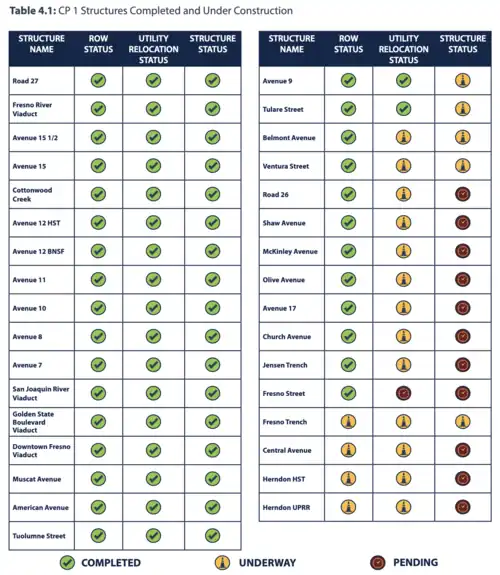
- CP1 comprises 32 miles (51 km) from Avenue 17 north of Madera to East American Avenue south of Fresno. It includes 12 grade separations, two viaducts, one tunnel, a major river crossing over the San Joaquin River, and the realignment of State Route 99. The contractor is the joint venture of Tutor-Perini/Zachry/Parsons.[50] The design-build contract was signed August 16, 2013. This construction package is forecast to be completed next, in 2026.[51]: 13
- REMAINING: 16 projects still need to be completed.

- CP2-3 comprises 65 miles (105 km) from East American Avenue south of Fresno to 1 mile (1.6 km) north of the Tulare / Kern County border. It includes approximately 36 grade separations, viaducts, underpasses, and overpasses. The contractor is the joint venture of Dragados USA/Flatiron Construction.[52] The design-build contract was signed June 10, 2015. This construction package is forecast to also be completed in 2026.[51]: 22
North and south extensions
Extensions of the line from the above central section north to Merced and south to Bakersfield, totaling about 52 additional miles (84 km), are also progressing through advanced design work, right-of-way mapping, and identification of utility relocation work. The Merced to Madera extension design contract ($41 million) was awarded to Stantec Consulting Services Inc., for approximately 33.9 miles (54.6 km) with 40 structures. The Shafter to Bakersfield (Locally Generated Alternative) extension design contract ($44.9 million) was awarded to HNTB for approximately 18.5 miles (29.8 km). with 31 structures. These design contracts are expected to last into 2024.[55]
Following these steps, land acquisition, infrastructure construction, and track and systems installation will still need to be accomplished before the extensions can become part of the operable Interim IOS before the end of the decade.
For the southern extension, on September 25, 2023 the Authority announced that it had received over $200 million in federal grants for 6 grade separations in Shafter, California. This will be the first construction in the Central Valley outside of the initial construction packages. Anticipated construction start dates are August 2025, and completion dates are August 2028.[56] These dates are consistent with the anticipated IOS completion schedule. Work designs still need to be finalized, and RFPs and contract awards still need to be issued.
Maintenance facilities
Only one Heavy Maintenance Facility (HMF) will be needed and it is proceeding through the planning and approval process. Its location has not been determined as yet, except it will be in the IOS segment.[57] The Maintenance Facilities Factsheet[58] provides an overview of the proposed maintenance facilities.
The 2023 Project Update Report[13] says (on pages 19–20), "Building upon the previous environmental work, a project level environmental clearance process is underway to select a preferred alternative site for the heavy maintenance facility. This facility will be developed and built as part of the trains procurement. It could be used for final assembly of the trainset and will be designed and built by the manufacturer to assure efficient train maintenance. Through this environmental review process, the preferred alternative will be selected that best meets the Authority's operational requirements." (Emphasis added.)
In addition to the HMF, there will also be 3 Light Maintenance Facilities built. No locations have been selected yet, however, one will be in the Bay Area,, one in the IOS, and one somewhere as yet undetermined in the southern portion of the system. There will also be 5 track maintenance facilities called Maintenance of Way facilities. Their locations are also not yet determined.
Statewide connectivity ("bookend") projects
According to the Authority: "Connectivity or 'Bookend' Projects refer to the billions of dollars in infrastructure investment throughout the state that are part of the California High-Speed Rail system. These funds will strengthen and improve existing rail networks, while also connecting them with California's future high-speed rail system. Senate Bill (SB) 1029[59] passed by the California Legislature and signed by Governor Brown in July 2012, invests almost $2 billion from the Safe, Reliable, High-Speed Passenger Train Bond Act for the 21st Century (Proposition 1A) into transit, commuter, and intercity rail projects across the state. This funding leverages approximately $5 billion in additional funding for these projects."[60]
Major "bookend" investments are underway in the northern and southern metropolitan areas:
- The Caltrain electrification "bookend" investment in the Bay Area (as well as grade separations, etc.) is proceeding, and is expected to be completed in late 2024.[61][62] Route electrification from San Jose to Gilroy is a future project. The very first bookend project to open to the public was Caltrain grade separations (in 2021); work on these is still continuing.[25] Note that the existing Caltrain track can only support maximum train speeds of 79 miles per hour (127 km/h) due to track curves, so since the HSR trains will be sharing track, in places the track will need to be redone in order to support the HSR 110 miles per hour (180 km/h) speeds.[27]
- A "bookend" investment in the "Link US" project (Phase A), converting Union Station (Los Angeles) from a "stub-ended track" station to a "run-through track" station, will shortly begin construction. Phase B still needs to be funded.[63]
There are many other connectivity projects partly funded by the Authority. Particularly significant are those which implement Positive Train Control systems on the commuter rail systems which will be part of the final blended system.[60]
Station updates
Grant applications for construction of the following stations:
- The Fresno High-Speed Rail Station Historic Depot Renovation and Plaza Activation Project in June 2023 was awarded a $20 million grant from the US DOT Rebuilding American Infrastructure with Sustainability and Equity (RAISE) program[27]
- The Merced Integrated Multimodal Station Project grant was submitted[64]
Design and support services contract let:
- Merced, Fresno, Kings/Tulare and Bakersfield.[65] This is for preliminary design work, and is expected to take about 30 months. (The second phase will develop plans ready for construction.)
Conceptual design work is proceeding with other stakeholders on the following stations:
Valley Rail and CAHSR
Valley Rail is an important component of statewide passenger rail in California which uses Union Pacific Railroad and Burlington Northern Santa Fe Railroad tracks. "The Valley Rail Program consists of several project segments that together improve rail service on ACE and the San Joaquins for the San Joaquin Valley, Sacramento, and the Bay Area."[68] When the IOS goes into service the San Joaquins service in the IOS (from Merced to Bakersfield) will be discontinued and replaced by CAHSR service. CAHSR passengers will connect to Valley Rail at the Merced Multi-Modal Transit Station (the northern terminus of the IOS). The remaining expanded Valley Rail service will remain in place, providing CAHSR rail passengers with continuing transportation north and west to the Bay Area and north towards/to Sacramento.[69] Valley Rail will also provide connections to other transit services through its 16 stations.
Valley Rail is currently in implementation, and has an estimated completion date before 2028.
Route and stations
The project aims to connect California's major metropolitan areas together, and link to their local commuter systems. It will be built in two major phases. Phase 1 connects San Francisco and the Bay Area through the San Joaquin Valley (the southern part of the Central Valley) to Anaheim in the Greater Los Angeles area, a distance of about 500 miles (800 km). Phase 2 extends the north end of the Central Valley section up to Sacramento, and extends the Los Angeles section in the south through the Inland Empire down to San Diego at the southern edge of the state, for a total system length of about 800 miles (1,290 km).
The route going through the mountains at the north and south of the Central Valley pose significant challenges. In particular, 2 tunnels will be required at the north, and 12 will be needed at the south. Three tunnels will each be longer than 10 miles, making them longer than any existing train tunnels in North America.
The number of stations on the completed system was limited by Proposition 1A to 24. At the start of operations of the Interim Initial Operating Segment (Interim IOS, Merced to Bakersfield) there will be 5 stations. These stations are discussed in the 2023 Project Update Report[13] on pages 12–15.
Route finalized from Central Valley to San Francisco
Although the Authority is focused on getting the Interim IOS in the Central Valley in operation by the end of the decade, it is also looking ahead to the next step (that is, connecting to San Francisco using the prepared Caltrain blended route). On April 28, 2022, it approved the final route in the San Jose to Merced section. This alignment (Alternative 4) uses the existing Union Pacific Railroad (UPRR) alignment from San Jose to Gilroy as a blended section. [70]
East of Gilroy the alignment becomes a pure HSR section with two tunnels, approximately 15 miles (24 km) in length, through the Pacheco Pass. Trains will be able to travel at 220 miles per hour (350 km/h) even through the tunnels. When tunnel field studies, early engineering, and design work are completed for this section, it will be ready for construction when funding is available. Tunnel construction is anticipated to take up to 6 years to complete once begun.[71]
Route travel-time and speed requirements
Proposition 1A[72] also set the maximum nonstop travel times between certain destinations on the system:
- San Francisco–San Jose: 30 minutes; this would require about 100 mph (160 km/h) on average
- San Jose–Los Angeles: 2 hours, 10 minutes; this would require about 200 mph (320 km/h) on average
- San Francisco–Los Angeles Union Station: 2 hours, 40 minutes
- San Diego–Los Angeles: 1 hour, 20 minutes
- Inland Empire–Los Angeles: 30 minutes
- Sacramento–Los Angeles: 2 hours, 20 minutes
In addition, the achievable operating headway between successive trains must be less than 5 minutes.[72]
The Federal Railway Administration (FRA) has a new regulatory scheme governing high speed passenger rail traffic. In TECHNICAL MEMORANDUM, Interoperability of Tier III HSR Trainsets with Tier I Operations, TM 600.03[73], the FRA's Engineering Task Force defines a top speed of 125 mph (201 km/h) for Tier I railroads (where the track is shared with other passenger and commuter rail as well as freight and has specified grade-crossing protections), and a top speed of 220 mph (350 km/h) for Tier III (where the track is exclusive to high-speed passenger service and is fully grade-separated). The CAHSR trains will be the highest speed trains in the United States, and the system as planned is fully compliant with this scheme. Tier I extends from San Francisco to Gilroy, and from Burbank to Anaheim; Tier III extends from Gilroy to Burbank. So, the entire Interim IOS is in Tier III.
Tier III operations require a very strong safety environment. Per Rachel Kesting, CAHSR Southern California Information Officer, "[I]t takes a high-speed train traveling at top speed approximately or up to 8 miles to come to a stop."[74] At top speed, each 10 seconds the train would be traveling over half a mile. Thus, stopping for a visually-observed hazard on the tracks would be impossible.
Trains (rolling stock)
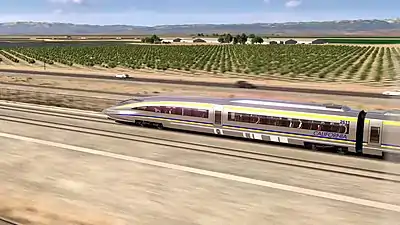
Acquisition
In January 2015, the Authority issued a request for proposal (RFP) for complete trainsets. In February 2015, ten companies formally expressed interest in producing trainsets for the system: Alstom, AnsaldoBreda (now Hitachi Rail Italy), Bombardier Transportation, CSR, Hyundai Rotem, Kawasaki Rail Car, Siemens, Sun Group U.S.A. partnered with CNR Tangshan, and Talgo.[75]
Due to company acquisitions and mergers since then (CSR merged with CNR, and Bombardier Transportation merged with Alstom), the number of companies qualified for the tender was reduced to seven. The qualified companies were Alstom, Siemens Mobility, Talgo, Hitachi Rail Italy, CRRC, Hyundai Rotem, and Kawasaki Rail Car.
An additional factor for the selection of a model is the Buy America regulation for production of rolling stock in the US. The Federal Railroad Administration granted a waiver for two prototypes to be manufactured off-shore. The remaining trainsets would need to be built according to the rules.[76] This requirement was mentioned as a significant reason that Chinese manufacturers dropped out of the Brightline West (then known as XpressWest) project with similar technical trainset specifications.[77]
However, there were no funds readily available for train purchase at the time, so no action was taken then. In May 2022 a grant request was submitted to the Biden administration for funds to purchase six HSR trainsets.[31] The 2023 Project Update Report projects the purchase of these to be made in 2024. In August 2023 the new process for trainset purchase was revealed, with a new request for qualifications (RFQ) and a new request for proposals (RFP). The RFQ has been adopted, and is in process now; the new RFQ will be sent to accepted bidders early in 2024. An early delivery of a trainset for testing purposes is anticipated for 2028, with delivery of the remaining ones by 2030.[19]
The 2023 Project Update Report states that for the entire Phase 1 system 66 trainsets will be needed.[78]
Train design
A fact sheet discussing train design is available.[79]
The Authority has created a 105 page draft train specification document (Sched_1PtA_Auth_TierIII_Trainsets_Spec_Rev0_013015_Industry_Working_Draft.pdf) which is not currently online. It may be requested from the Authority, however. Some of the train specifications are:
- each trainset will have a sustained continuous speed of 220 mph (350 km/h);
- a maximum testing speed of 242 mph (389 km/h);
- a lifespan of at least 30 years;
- a length no longer than about 680 feet (210 m);
- the ability to operate two trainsets as a single "consist" (a long train);
- have control cabs at both ends of each trainset and the ability to go equally well in either direction;
- pass-by noise levels (82 feet (25 m) from track) not to exceed 88 dB at 155 mph (249 km/h) and 96 dB at 220 mph (350 km/h);
- have at least 450 seats and carry 8 bicycles;
- have seating for first class and business class passengers as well as space for wheelchairs;
- have food service similar to airplane-style serving;
- allow for use of cellphones, broadband wireless internet access, and onboard entertainment services;
- have a train communications network to notify passengers of travel / train / station / time information; and
- have earthquake safety systems for safe stopping and exiting.
The following renderings of the train interior are shown on page 19 of the 2023 Project Update Report.
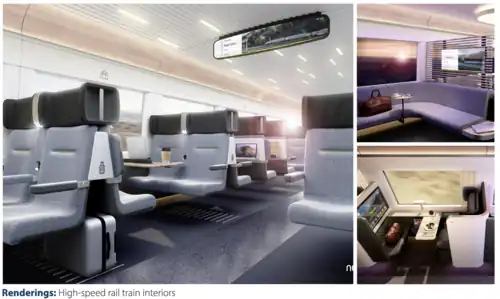
Train station-sharing
The CAHSR trains will use a different standard than Caltrain for their floor height above the rails. The CAHSR trains have a floor height of 50.5 in (128 cm) above the rails, which is significantly higher than the 22 in (56 cm) floors of Caltrain's commuter trainsets. To resolve this issue, Caltrain is procuring new Stadler KISS EMUs that have doors at both heights.[3][80] Each train platform uses either one height or the other, and only a few of the Bay Area stations will service both types of trainsets. Thus, in the Bay Area most of the stations will be used exclusively by Caltrain and not be able to support CAHSR trainsets.
HSR passenger line operations
Request for qualifications
In April 2017, the CHSRA announced it had received five responses to its request for qualifications for the contract to assist with the development and management of the initial phase of the high-speed line and be the Interim IOS operator.[81][82]
- China HSR ETO Consortium: China Railway International, Beijing Railway Administration, China Railway Eryuan Engineering Group, China Railway Corporation
- DB International US: DB International USA, Deutsche Bahn, Alternate Concepts, HDR
- FS First Rail Group: Ferrovie dello Stato Italiane, FirstGroup, Trenitalia, Rete Ferroviaria Italiana, Centostazioni, Italferr, McKinsey & Company
- Renfe: Renfe Operadora, Globalvia Inversiones, Administrador de Infraestructuras Ferroviarias
- Stagecoach Group: Stagecoach Group, Coach USA
Selected early train operator
In October 2017, the California High-Speed Rail Authority announced that DB ECO North America Inc (formerly known as DB Engineering & Consulting USA Inc.) had been chosen as the early train operator.[83] This decision came after a request for qualifications was put out by the authority looking for well established groups able to provide operational guidance for the future system once opened.
Services provided by DB International US are:
- Project management
- Ridership and passenger revenue forecasts
- Preferred revenue collection systems
- Rolling stock fleet size and interior layout
- Service planning and scheduling
- Operations and maintenance cost forecasting
- Station design & operations
- Optimization of life cycle costs
- Procurements
- Fare integration and Interoperability
- Safety and security
- Operations control/dispatching responsibilities
- Maximizing system revenues
- Marketing and branding
Ridership estimates
DB ECO North America Inc. (the early train operator) had also done an analysis of likely ridership using updated data and a newer model. Based on their estimates per the 2023 Project Update Report, ridership from the service implementation date to 2040 would total about 11.49 million riders annually for the Silicon Valley to Bakersfield service, and 31.28 million riders annually for the entire Phase 1 system. This estimate used a new California Rail Ridership Model, updated assumptions and data (from 2022), revised service plan assumptions, a revised fare policy, and a new rider behavior model.[84]
These ridership estimates show the CAHSR system will have higher projected ridership than all California Amtrak–supported services combined: 6.6 million vs 5.6 million riders. CAHSR will also carry more than two-and-a-half times more riders annually than the 12.5 million riders reported on the Northeast Corridor high speed service.
Legal aspects
This project already has a long history. Topics included in the main History page (the link shown above) include the early history (before 2015), discussion of HSR alternatives, legislation, financing, construction, and legal challenges.
Legislation
In 1996, the California High-Speed Rail Authority (CHSRA) was established to begin formal planning in preparation for a ballot measure in 1998 or 2000.[85][86]
In 2008, California voters approved Proposition 1A to construct the initial segment of the high-speed rail network, and issued $9 billion in bonds to begin its construction.[87] The proposition also set certain requirements for the project:[88]
- Established the basic route linking the major population centers
- Minimum 200 miles per hour (320 km/h) where conditions permit
- Maximum of 24 stations on the system
- Maximum travel times between certain points
- Financially self-sustaining (operation and maintenance costs fully covered by revenue)
The proposition also authorized an additional $950 million for improvements on local commuter systems, which will serve as feeder systems to the high-speed rail system.
In June 2014, state legislators and Governor Jerry Brown agreed to apportion the state's annual cap and trade funds so that 25% goes to high-speed rail as an ongoing source of funds.[89]
Lawsuits
In 2014, the CHSRA was challenged on its compliance with its statutory obligations under Proposition 1A (John Tos, Aaron Fukuda, and the Kings County Board of Supervisors v. California High-Speed Rail Authority). In November 2021 a circuit court ruled against the plaintiffs.
On December 15, 2014, the federal Surface Transportation Board determined that its approval of the HSR project in August "categorically preexempts" lawsuits filed under the California Environmental Quality Act (CEQA). This determination was tested in a similar case, Friends of Eel River v. North Coast Railroad Authority. The Supreme Court of California determined on July 27, 2017, that CEQA is not exempted by federal law.[90][91]
In February 2022, Hollywood Burbank Airport sued the authority over its approval of the draft EIR for that section of the high-speed railway.[92]
Economic costs/benefits and environmental impacts
In addition to the direct reduction in travel times the HSR project will produce, there are other anticipated benefits, economic and environmental, both generally to the state and to the regions the train will pass through, and also to the areas immediately around the train stations. Some of the items of note include:
- On February 14, 2023, the Authority announced that 10,000 construction jobs had been created on the HSR project.[93]
- The Central Valley Training Center is a pre-apprenticeship job training program operated by CAHSR to help train local workers and get them jobs on the project. It has been operating since 2020; it has trained 151 people, assisted with their job placement, and received over 1000 student inquiries.[94]
- The Authority produces an annual Sustainability Report on its efforts to both build the HSR system in a sustainable way, but also its estimates on the effects of the HSR system. For example, it indicates that the project generated between $12.7 and 13.7 billion in total economic activity in the state, with 56% investment in disadvantaged communities.[95]
- The Authority also produces an annual cumulative report on the economic benefits of the HSR project. The Authority has a two-page fact sheet available for 2023,[96] and a 39-page detailed report dated March 9, 2023.[97]
Peer review, public opinion, and criticism
There are two types of review and criticism noted here: the legally established "peer review" process that the California legislature established for an independent check on the authority's planning and implementation efforts,[98] and public criticisms by groups, media, individuals, public agencies, and elected officials.
At the February 2015 conference Bold Bets: California on the Move?, hosted by The Atlantic magazine and Siemens, Dan Richard, the then-chair of the authority, warned that not all issues facing the HSR system had been resolved.[99]
California High-Speed Peer Review Group
The California Legislature established the California High-Speed Rail Peer Review Group to provide independent analysis of the Authority's planning and implementation efforts. Their documents are submitted to the Legislature as needed.
The April 1, 2022, report[100] noted a number of positive factors:
- Improved prospects for federal funding with the Biden Administration
- Disruptions and impacts caused by COVID-19, the war in Ukraine, and inflation are all noted but being dealt with
- Significant progress has been made on the necessary environmental clearances
- Greater attention is being given to local transit connectivity and local economic impacts
- Major improvements have been made to project management and risk mitigation
However, there were also a number of significant concerns noted:
- The total level of uncertainty has likely increased due to effects of COVID-19 and inflation.
- Prior experience with cost increases and scheduling delays raises some uncertainties about future performance. Cost increases have been over 86%, average delays have been 118%, only 90% of ordinary real estate parcel needed have been acquired, only 63% of railroad parcels have been acquired, and only 65% of utility parcels have been acquired.
- Some of the cost estimates presented were out of date, but expected to be updated in the 2023 Project Update Report.
- Major components of the project (representing over half its cost) have no bidding or contract management experience. Thus, estimates for these are clearly suspect.
- There are critical issues regarding management and legal issues with other agencies for the operation of the system which remain unresolved. (There are a number of these listed, as well as unknown long-term impacts of COVID-19 on ridership and inflation.)
- Adequate legislative oversight is lacking.
- Per the report, "[O]verall project funding remains inadequate and unstable making effective management extremely difficult. In addition, the Authority has no clear guidance from the Legislature on the next steps in the project."
- "Even with a realistic share of new Federal funding, the project cannot get outside the Central Valley without added state or local funding from sources not yet identified."
Professional studies of blended systems
Study #1. Eric Eidlin, an employee of the Federal Transit Administration (Region 9, San Francisco), wrote a study in 2015 funded by the German Marshall Fund of the United States comparing the structural differences of two HSR European systems and their historical development with California's HSR system.[101] He also focused on the issue of station siting, design, use, and impact on the surrounding community. From this, he developed ten recommendations for CAHSRA. Among these are:
- Develop bold, long-term visions for the HSR corridors and stations.
- Where possible, site HSR stations in central city locations.
- In rural areas, emphasize train speed; in urban areas, emphasize transit connectivity.
- Plan for and encourage the non-transit roles of the HSR stations.
Eidlin's study also notes that in California there has been debate on the disadvantages of the proposed blended service in the urban areas of San Francisco and Los Angeles, including reduced speeds, more operating restraints, and complicated track-sharing agreements. There are some inherent advantages in blended systems that have not received much attention: shorter transfer distances for passengers, and reduced impacts on the neighborhoods. Blended systems are in use in Europe.[102]
Study #2. A 202-page study by A. Loukaitou-Sideris, D. Peters, and W. Wei of the Mineta Transportation Institute at San Jose State University in 2015 compared examples of "blended systems" in Spain and Germany where conventional and high-speed rail (HSR) services either used the same tracks over a portion of track or at a specific station.[103] The study found that blended systems were cheaper to build, required less space, and provided easy transfers between different modes of transportation, but resulted in lower system capacity (due to greater separation distances required when combining HSR and conventional traffic), were often not possible to properly implement in urban areas due to the additional land area requirements for passing sidings, resulted in additional challenges in operations, and caused frequent delays.[104]
Public opposition
In 2008 the Reason Foundation, the Howard Jarvis Taxpayers Association, and Citizens Against Government Waste, published a study which they named the "Due Diligence Report" critiquing the project.[105] In 2013, the Reason Foundation published an "Updated Due Diligence Report".[106] The Reason Foundation is libertarian, the Howard Jarvis Taxpayers Association is officially non-partisan but lobbies against raising taxes, and Citizens Against Government Waste functions as a 'government watchdog' and advocacy group for fiscally conservative causes. Key elements of the updated critique include:
- operating train speed higher than any existing HSR system at the time
- unrealistic ridership projections
- increasing costs
- no clear funding plan
- incorrect assumptions regarding HSR alternatives
- increasing fare projections
This 2013 critique was based on the 2012 Business Plan. Although the 2012 Business Plan has been superseded by subsequent business plans, the critique does include the Blended System approach sharing commuter tracks in SF and LA which has officially been adopted by the Authority. (The blended system is commonly used in Europe for its advantages of substantial cost savings, reduced land requirements, and better passenger convenience.)
James Fallows in The Atlantic magazine summarized public criticism thus, "It will cost too much, take too long, use up too much land, go to the wrong places, and in the end won't be fast or convenient enough to do that much good anyway."[107]
In 2013, a different type of criticism was leveled at the proposed HSR system when the idea of using a "blended" system with Caltrain was promoted. It was felt that this idea did not meet the original Proposition 1A plan due to the resulting lower operating speeds, fewer trips, and fewer riders.[108]
Public opinion
Public approval for CAHSR has remained steady over the years:
In April 2022, UC Berkeley's Institute of Government Studies released a survey of registered voters that found 56% supported continuing the high-speed rail project even if "its operations only extend from Bakersfield to Merced in the Central Valley by the year 2030 and to the Bay Area by the year 2033."[109] Approval varies by political affiliation with 73% of Democrats backing the project versus 25% of Republicans.
An older statewide survey, in March 2016, by the Public Policy Institute of California (PPIC) indicated that 52% of Californians support the project, while 63% of Californians think the project is either "very important" or "somewhat important" for California's economy and quality of life. Support varies by location (with the San Francisco Bay Area the highest at 63%, and lowest in Orange/San Diego at 47%), by race (Asians 66%, Latinos 58%, Whites 44%, and Blacks 42%), by age (declining sharply with increasing age), and by political orientation (Democrats 59%, independents 47%, and Republicans 29%).[110] Dan Richard, then-chair of the authority, said in an interview with James Fallows that he believes approval levels will increase when people can start seeing progress, and trains start running.[99]
In 2008, voters approved Proposition 1A with 52.6%.
Las Vegas HSR project (Brightline West)
Brightline West (formerly Desert Xpress and XpressWest) is a project that since 2007 has been planning to build a high-speed rail line between Southern California and Las Vegas, Nevada, part of the "Southwest Rail Network" they hope to create. The rail line will begin in Las Vegas, cross the Mojave Desert to a station 5 miles (8.0 km) outside of Victorville, California, and terminate in Rancho Cucamonga in the Inland Empire (where it will connect with Metrolink and eventually CAHSR when it gets built out to that point). This route will total about 230 miles (370 km). A second branch about 50 miles (80 km) long is also planned going westward from Victorville and terminate in Palmdale (located on the west side of the high desert) where it will connect with CAHSR as it passes through on its way north into the Central Valley.
A start date for construction of Brightline West is set for the second half of 2023.
Further study (external links)
CAHSR Authority documents
The Authority's latest financial projections and its current implementation strategy are discussed in detail in the 2023 Project Update Report.[13]
The Authority's Business Plan[111] describe the project's goals, financing, and development plans. This is updated every even year (since 2008), and must be submitted to the Legislature by May 1.
The Authority's Project Update Report[112] gives a program-wide summary, as well as information for each project section, in order to clearly describe the project's status. This is produced every odd year (since 2015, except for 2021), and must be submitted to the Legislature by March 1.
The Authority's Newsroom[113] provides frequent news releases concerning all aspects of the project.
The Authority's Info Center[114] provides factsheets, regional newsletters, maps, and video simulations of route "fly-overs".
Independent reviews
The California Peer Review Group produces independent analysis of the project for the state legislature.[115] Its documents are currently available on its website. The latest report by the PRG is the Letter to the Legislature (March 23, 2023).[37]
The state legislature also has provided that independent financial review be conducted of the authority's plans. The firm Project Finance Advisory Limited (PFAL) was selected to do this beginning in November 2015. The September 2022 review is available at Independent Financial Advisor Report To California High-Speed Rail Authority Regarding: Proposition 1A Funding Plan.[116]
Other documents
From 2014 to 2015, James Fallows wrote a series of 18 articles for The Atlantic about the HSR system. The series covered many aspects of the system, criticisms of it, and responses to those criticisms. See
- The California High-Speed Rail Debate—Kicking Things Off [117]
- California High-Speed Rail—the Critics' Case [118]
- California High-Speed Rail No. 3: Let's Hear From the Chairman [119]
- 7 Ways in Which High-Speed Rail Would Help California, According to Its Chairman [120]
- California High-Speed Rail: 10 Readers With 10 Views [121]
- California High-Speed Rail: Some Views From the Valley [122]
- The Courts Speak Up for California High-Speed Rail [123]
- California High-Speed Rail—More Questions and Concerns [124]
- California High-Speed Rail No. 9—the Chairman's Turn Again [125]
- California High-Speed Rail No. 10: Palate Cleanser [126]
- California High-Speed Rail No. 11: Thinking in Time [127]
- All Aboard for the California High-Speed Rail Chronicles! [128]
- California High-Speed Rail Lucky No. 13: Let's Look at Maglev and Other Alternatives [129]
- Why You Shouldn't Get Your Hopes Up for the Self-Driving Car (California High-Speed Rail No. 14) [130]
- California High-Speed Rail: It's Happening [131]
- That Winning Bid for California's High-Speed Rail: Is It Suspiciously Low? [132]
- California High-Speed Rail: A Minor End, an Important Beginning [133]
- [summary] California High-Speed Rail: The Collector's Edition [134]
The High Speed Rail Alliance is a non-profit organization dedicated to promoting high speed rail systems in the United States. They have information nation-wide about current developments as well as plans and tutorials.
Videos
CNBC has a 15 minute video (from May 16, 2023) on the CAHSR project, Why California’s High-Speed Rail Is Taking So Long.
High Speed Rail Alliance links to this 73 minute video of a panel discussion by experts hosted by Streetsblog California (from summer 2023), Complete California High Speed Rail In Five Years?.
References
- California High-Speed Rail Authority. "Implementation Plan" (PDF). pp. 23, 25. Archived from the original (PDF) on September 10, 2008. Retrieved July 17, 2008.
- "TECHNICAL MEMORANDUM: Traction Power 2x25kV Autotransformer Feed Type Electrification System & System Voltages" (PDF). HSR.CA.gov. CHSRA. Retrieved November 3, 2016.
- "KISS Double-Decker Electric Multiple Unit EMU for Peninsula Corridor Joint Powers Board (CALTRAIN), California, USA" (PDF). Archived from the original (PDF) on October 6, 2016. Retrieved October 16, 2016.
- "HSR Q+A: Blended System & Passing Tracks with Boris Lipkin". California High-Speed Rail Authority. 2020. Archived from the original on December 12, 2021. Retrieved October 12, 2020.
- "ES.0 Executive Summary: ES.1 Supplemental Alternatives Analysis Report Results" (PDF). Hsr.ca.gov. Retrieved January 14, 2016.
- "California High-Speed Rail Authority Moves Closer to Buying First Trainsets". California High-Speed Rail Authority. August 24, 2023. Retrieved September 11, 2023.
- "Letter to the Legislature (March 23, 2023)" (PDF). cahsrprg.com. March 23, 2023. Retrieved May 29, 2023.
- "quote from February 14, 2023, CEO Report to Board" (PDF).
- "NEWS RELEASE: High-Speed Rail Authority Receives Nearly $202 Million from Federal Government". CAHSR Authority. Retrieved September 25, 2023.
- "CALIFORNIA HIGH-SPEED RAIL: SIX GRADE SEPARATIONS IN THE CITY OF SHAFTER" (PDF). California High-Speed Rail Authority. CAHSR. Retrieved September 28, 2023.
- Walters, Dan (July 20, 2022). "Troubled bullet train project given a reprieve". CalMatters. Retrieved January 5, 2023.
- "2022 Proposition 1A Funding Plan, September 2022" (PDF). California High-Speed Rail Authority. Retrieved December 29, 2022.
- "2023 Project Update Report". CHSR Authority.
- "Peer Review Group's 2022 report to the state legislature" (PDF). Retrieved May 29, 2023.
- https://dot.ca.gov/-/media/dot-media/programs/rail-mass-transportation/documents/california-state-rail-plan/20230309-casrp-public-dor-guidance.pdf
- https://dot.ca.gov/-/media/dot-media/programs/rail-mass-transportation/documents/california-state-rail-plan/20230406a-srpfactsheet-a11y.pdf
- "Board of Directors Meeting Schedule". California High-Speed Rail. Retrieved October 11, 2023.
- https://hsr.ca.gov/about/board-of-directors/ceo-report/2023-ceo-reports/ceo-report-june-2023/
- https://hsr.ca.gov/wp-content/uploads/2023/07/July-27_2023_Agenda-Item-3_-Track-and-System-Procurement-Slides-for-Board__FINAL.pdf
- https://hsr.ca.gov/2023/08/24/news-release-california-high-speed-rail-authority-moves-closer-to-buying-first-trainsets/
- "Request for Qualifications for High-Speed Trainsets and Related Services RFQ No.: HSR23-18" (PDF). Retrieved September 8, 2023.
- "Major Construction Under Way on High-Speed Rail Project : CEG".
- High-Speed Rail: Central Valley at a Glance California High-Speed Rail Authority
- 2022 Business Plan California High-Speed Rail Authority
- https://hsr.ca.gov/wp-content/uploads/2023/08/08-24-2023-NorCal-Update-to-August-Board-Meeting-A11Y.pdf
- "Tunneling in Northern California, SAN JOSE TO MERCED PROJECT SECTION FACTSHEET" (PDF).
- "ALL ABOARD Summer Quarterly Newsletter". Retrieved September 7, 2023.
- "California High-Speed Rail 2022 Business Plan". California High-Speed Rail Authority. September 2022. Retrieved November 6, 2022.
- California High-Speed Rail Board Approves Design Contracts to Prepare for Construction into Merced and Bakersfield California High-Speed Rail Authority
- $25 Million in Federal Funding Awarded to Advance High-Speed Rail in California California High-Speed Rail Authority
- California High-Speed Rail Authority Pursues First Major Award Of New Federal Infrastructure Funds California High-Speed Rail Authority
- California High-Speed Rail Board Awards Design Contract for Central Valley Stations California High-Speed Rail Authority
- California High-Speed Rail Authority to Restructure Track and Systems Procurement California High-Speed Rail Authority
- "NEWS RELEASE: California High-Speed Rail Authority Pursues First Major Award Of New Federal Infrastructure Funds". CAHSRA.
- "2022 Business Plan" (PDF). p. 52.
- Get the facts California High-Speed Rail Authority
- https://www.cahsrprg.com/wp-content/uploads/sites/15/2023/03/Final-to-legislature-3-23-2023.pdf
- https://hsr.ca.gov/wp-content/uploads/2022/09/2022-Proposition-1A-Funding-Plan-091622-A11Y.pdf
- "Independent Financial Advisor Report To California High-Speed Rail Authority Regarding: Proposition 1A Funding Plan" (PDF). Retrieved January 5, 2023.
- California High-Speed Rail Applies for Millions in New Federal Funds to Advance Construction Toward Bakersfield California High-Speed Rail Authority
- 2022 Business Plan California High-Speed Rail Authority
- https://hsr.ca.gov/wp-content/uploads/2023/08/August-24-2023-Agenda-Item-4-Board-Memo-Battery-Solar-Strategy-A11Y.pdf
- Kelly, Brian. "August 2023 CEO Report". Retrieved September 7, 2023.
- San Joaquin River Viaduct Chosen as Structure Project of the Year by the California Transportation Foundation California High-Speed Rail Authority
- "Construction by the Numbers (as of May 2023)". Sacramento: California High Speed Rail Authority. Retrieved September 14, 2023.
- Kelly, Brian. August 2023 CEO Report (Report). Sacramento: California High Speed Rail Authority. Retrieved September 7, 2023.
- "PHOTO RELEASE: High-Speed Rail Authority Completes Overcrossing in Kern County" (Press release). Sacramento: California High Speed Rail Authority. Retrieved July 30, 2023.
- CAHSR Authority. "PHOTO RELEASE: High-Speed Rail Authority Celebrates Completion of Grade Separation Project in City of Wasco". Retrieved August 5, 2023.
- "High-Speed Rail Authority Completes Seventh Structure in Central Valley in 2023" (Press release). Sacramento: California High Speed Rail Authority. Retrieved August 13, 2023.
- "BuildHSR | California High-Speed Rail Authority | Construction Package 1".
- Central Valley Status Report California High-Speed Rail Authority
- "BuildHSR | California High-Speed Rail Authority | Construction Package 2-3".
- CAHSR Authority. "PHOTO RELEASE: PHOTO RELEASE: High-Speed Rail Completes Overcrossing in Fresno County". Retrieved July 30, 2023.
- CAHSR Authority. "PHOTO RELEASE: PHOTO RELEASE: High-Speed Rail Completes Overcrossing in Fresno County". Retrieved July 30, 2023.
- "Despite Hurdles, Pushback, Major Construction Under Way On High-Speed Rail Project". Construction Equipment Guide. November 15, 2022. Retrieved December 26, 2022.
- "NEWS RELEASE: High-Speed Rail Authority Receives Nearly $202 Million from Federal Government". CAHSR Authority. Retrieved September 28, 2023.
- "2022 Business Plan" (PDF). p. 42.
- https://hsr.ca.gov/wp-content/uploads/2023/01/Maintenance-Facilities-Factsheet.pdf
- "Senate Bill No. 1029". California Legislature. Retrieved December 27, 2022.
- "Connectivity Projects". California HSRA. Retrieved December 27, 2022.
- "Caltrain Electrification Delayed to 2024 | Caltrain". June 3, 2021.
- "Caltrain Electrification" (PDF). Northern California Regional Update, August 24, 2023. CAHSR Authority. Retrieved September 6, 2023.
- "Metro to Approve Early Phase of Union Station Run-Through Tracks Construction". May 24, 2022.
- Kelly, Brian. "August 2023 CEO Report". Retrieved September 7, 2023.
- "NEWS RELEASE: California High-Speed Rail Board Awards Design Contract for Central Valley Stations (October 20, 2022)". Retrieved September 12, 2023.
- Lipkin, Boris. "Northern California Regional Update August 2023" (PDF). Retrieved September 7, 2023.
- Lipkin, Boris. "Northern California Regional Update August 2023" (PDF). Retrieved September 7, 2023.
- "Valley Rail". Valley Rail. San Joaquin Regional Rail Commission. Retrieved September 27, 2023.
- "Merced County 2022 Regional Transportation Plan". Merced County. Merced County. Retrieved September 27, 2023.
- "San Jose to Merced Project Section, Final Environmental Impact Report, Final Environmental Impact Report/Environmental Impact Statement, Executive Summary, February 2022" (PDF). Retrieved December 30, 2022.
- "Tunneling in Northern California, SAN JOSE TO MERCED PROJECT SECTION FACTSHEET" (PDF).
- "Official Voter Information Guide – Proposition 1A" (PDF). California State Legislature. 2008. Retrieved March 22, 2018.
- https://hsr.ca.gov/wp-content/uploads/docs/programs/eir_memos/Proj_Guidelines_TM600_03R0.pdf
- quoted from private email sent from rachel.kesting@hsr.ca.gov on October 19, 2023
- "Expressions of Interest Received : HSR 14-30: Request for Expressions of Interest for Tier III Trainsets" (PDF). Hsr.ca.gov. Archived from the original (PDF) on June 2, 2019. Retrieved October 4, 2018.
- "In California's high-speed train efforts, worldwide manufacturers jockey for position". The Fresno Bee. December 27, 2014. Retrieved February 18, 2015.
- "XpressWest, seeking to build U.S. high-speed rail, ends deal with China group". Reuters.com. June 9, 2016.
- "2023 Update Report" (PDF). 2023 Update Report. Retrieved March 5, 2023.
- https://hsr.ca.gov/wp-content/uploads/2023/06/Designing-Train-Interiors-A11Y.pdf
- "Rail News - New Caltrain trainsets, Sound Transit rail cars arrive. For Railroad Career Professionals". Progressive Railroading. Retrieved November 29, 2022.
- Operators from five countries interested in California high speed rail contract Railway Gazette International April 6, 2017
- International consortia bid to become California high speed rail early operator Archived April 7, 2017, at the Wayback Machine Global Rail News April 6, 2017
- DB consortium selected for California high speed rail consultancy contract Railway Gazette International October 9, 2017
- "2023 Project Update Report" (PDF). Retrieved February 22, 2023.
- "SB 1420 Senate Bill – Chaptered". ca.gov. Retrieved January 14, 2016.
- "California High-Speed Rail Authority". Hsr.ca.gov. Retrieved January 14, 2016.
- "California Proposition 1A, High-Speed Rail Act (2008)". ballotpedia.org. Retrieved January 14, 2016.
- "AB 3034". State of California. Retrieved August 2, 2017.
- "Cap-and-Trade Revenue: Likely Much Higher Than Governor's Budget Assumes". ca.gov. Retrieved January 14, 2016.
- Sheehan, Tim (June 2, 2015). "Farm Bureaus jump into Supreme Court high-speed rail case". The Fresno Bee.
- "FindLaw's Supreme Court of California case and opinions".
- "Hollywood Burbank Airport files environmental lawsuit against California's bullet train". Los Angeles Times. February 25, 2022.
- "PHOTO RELEASE: California High-Speed Rail Celebrates Creating 10,000 Construction Jobs". CAHSRA. February 14, 2023. Retrieved February 15, 2023.
- "PHOTO RELEASE: High-Speed Rail Recognizes 10th Cohort to Complete Pre-Apprenticeship Training Program". October 6, 2023.
- "California High-speed Rail Authority Releases 2022 Sustainability Report". October 10, 2022.
- "The Economic Impact of California High-Speed Rail" (PDF). Retrieved September 11, 2023.
- "High-Speed Rail Authority 2022 Economic Impact Analysis Technical Supporting Document" (PDF). CAHSR Authority. Retrieved September 11, 2023.
- Official website: California High-Speed Rail Peer Review Group
- "Bold Bets: California on the Move?". The Atlantic. February 25, 2015.
Video of event
- California High-Speed Rail Peer Review Group. "April 2022 Report" (PDF).
- Eidlin, Eric (June 2015). "Making the Most of High-Speed Rail in California: Lessons from France and Germany".
- "Blended Service". Midwesthsr.org. June 7, 2013. Retrieved October 4, 2018.
- "Promoting Intermodal Connectivity at California's High-Speed Rail Stations" (PDF). Hsr.ca.gov. November 8, 2017. Retrieved January 14, 2021.
- "Promoting Intermodal Connectivity at California's High-Speed Rail Stations" (PDF). Hsr.ca.gov. November 8, 2017. p. 2. Retrieved January 14, 2021.
- "The California High Speed Rail Proposal: A Due Diligence Report" (PDF). Hsr.ca.gov. Retrieved January 14, 2016.
- "An Updated Due Diligence Report" (PDF). Hsr.ca.gov. Retrieved January 14, 2016.
- Fallows, James (July 11, 2014). "California High-Speed Rail – the Critics' Case". The Atlantic.
- Pandika, Melissa M. (March 3, 2013). "Caltrain electrification churns high-speed rail controversy". Peninsula Press. Archived from the original on April 1, 2017. Retrieved March 25, 2017.
- Mark DiCamillo (2022). Release #2022-08: Voters offer a wide range of issues they'd like the state to address (Report). UC Berkeley Institute of Governmental Studies. Retrieved November 4, 2022.
- "Californians & Their Government" (PDF). Ppic.org. p. 20. Retrieved October 4, 2018.
- https://hsr.ca.gov/about/high-speed-rail-business-plans/
- hsr.ca.gov/about/project-update-reports/
- https://hsr.ca.gov/communications-outreach/newsroom/
- https://hsr.ca.gov/communications-outreach/info-center/
- "California High Speed Rail Peer Review Group". California High Speed Rail Peer Review Group. Retrieved August 21, 2023.
- https://hsr.ca.gov/wp-content/uploads/2022/09/Prop-1A-Funding-Plan-Independent-Financial-Advisor-Report-FINAL-090722-A11Y.pdf
- https://www.theatlantic.com/business/archive/2014/07/the-california-high-speed-rail-debate-kicking-things-off/374135/
- https://www.theatlantic.com/politics/archive/2014/07/california-high-speed-railmdashthe-critics-speak/374306/
- https://www.theatlantic.com/politics/archive/2014/07/california-high-speed-rail-3lets-hear-from-the-chairman/374352/
- https://www.theatlantic.com/politics/archive/2014/07/7-ways-in-which-high-speed-rail-would-help-california-according-to-its-chairman/374408/
- https://www.theatlantic.com/politics/archive/2014/07/california-high-speed-rail-what-readers-want/374776/
- https://www.theatlantic.com/national/archive/2014/07/california-high-speed-railemdashsome-views-from-the-san-joaquin-valley/375125/
- https://www.theatlantic.com/national/archive/2014/08/the-courts-speak-up-for-california-high-speed-railand-so-do-some-readers/375518/
- https://www.theatlantic.com/politics/archive/2014/08/high-speed-rail-more-questions/379046/
- https://www.theatlantic.com/national/archive/2014/08/california-high-speed-rail-no-9the-chairmans-turn-again/379381/
- https://www.theatlantic.com/national/archive/2014/08/california-high-speed-rail-no-10-palate-cleanser/379422/
- https://www.theatlantic.com/national/archive/2014/09/california-high-speed-rail-no-11-thinking-in-time/379726/
- https://www.theatlantic.com/technology/archive/2014/10/all-aboard-for-the-california-high-speed-rail-chronicles/381386/
- https://www.theatlantic.com/business/archive/2014/10/california-high-speed-rail-lucky-no-13-lets-look-at-maglev/381638/
- https://www.theatlantic.com/technology/archive/2014/10/why-you-shouldnt-get-your-hopes-up-for-the-self-driving-car-calif-high-speed-rail-no-14/381850/
- https://www.theatlantic.com/politics/archive/2014/12/california-high-speed-rail-its-happening/383733/
- https://www.theatlantic.com/politics/archive/2014/12/that-winning-bid-for-californias-high-speed-rail-is-it-too-low/383737/
- https://www.theatlantic.com/politics/archive/2015/01/california-high-speed-rail-an-end-and-an-important-beginning/384238/
- https://www.theatlantic.com/politics/archive/2015/01/california-high-speed-rail-the-collectors-edition/384443/
